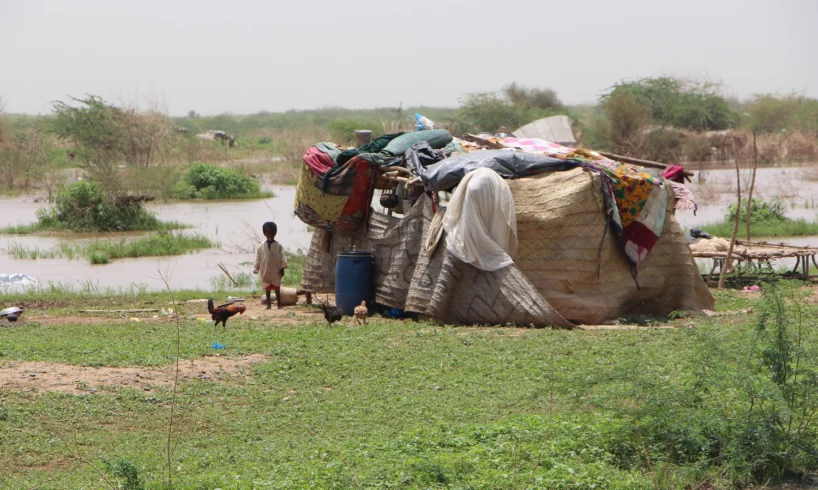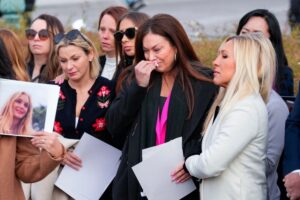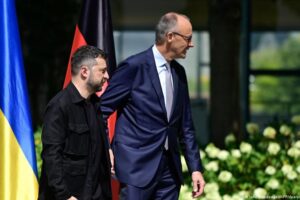
Since gaining independence in 1956, the country has rarely known peace. Civil wars, ethnic persecution, and decades of neglect have shaped the lives of millions — and still mark the country’s reality today.
Sudan is facing one of the world’s worst humanitarian crises.
As of January 2025, almost half of its population — around 21 million people — are in need of aid. Famine has been officially declared in parts of the country. Nearly 12 million people have been forced to flee their homes: more than seven million within Sudan and over four million abroad, mostly to neighbouring Chad and Egypt.
Sudan has been caught up in multiple overlapping conflicts for decades — too many to cover in a single story. In this piece, we focus on several of the main wars and the key forces involved, while also exploring the broader context needed to understand the country’s current crisis.
For this article, we spoke with Nathaniel Raymond from the Humanitarian Research Lab at Yale School of Public Health, which has spent years analysing global conflicts using satellite imagery and open-source data, including extensive research on Sudan. We also interviewed Yurii Oliinyk from the Centre for African Studies, who explained the roles of Russia and Ukrainian special forces in the conflict.
Civil wars in Sudan, 1955-1972, 1983-2005
Sudan gained independence from British-Egyptian rule in 1956. The new state was more than five times the size of Germany, stretching from the Egyptian border in the north to Uganda and the Democratic Republic of the Congo in the south — a vast and diverse land spanning the Sahara, the Sahel, and the tropical savannahs.
Tensions had already begun to build before independence. In 1955, the southern regions rose up against the central government in Khartoum. The main fault lines were ethnic and religious: the south, with its diverse population and mix of faiths, was marginalised by the Arab-Muslim majority that dominated political power. Southern communities were excluded from the government and saw their rich natural resources exploited by the centre.
The first civil war, which ended in 1972, brought the south limited autonomy — but only for a decade. In 1983, the conflict reignited when the government revoked that autonomy and imposed Islamic Sharia law, first under President Jaafar Nimeiri and later under dictator Omar al-Bashir, whose regime was marked by corruption, kleptocracy, and hardline pro-Arab, pro-Islamic policies.
The second civil war lasted until 2005, killing around two million people and displacing twice as many. It ended with the signing of the Comprehensive Peace Agreement, paving the way for the creation of a new independent state — South Sudan.
Sudan was thus divided into two countries: South Sudan, roughly the size of Ukraine, and the Republic of Sudan (often referred to simply as Sudan), which is about three times larger.
War in Darfur, 2003-2009
At the same time as the war in the south, another conflict broke out in Darfur — a vast region in western Sudan about the size of Spain. The violence in Darfur targeted non-Arab communities such as the Fur, Masalit and Zaghawa, and the current crisis is often seen as a continuation of those attacks. Most people in Darfur are Muslim but belong to different ethnic groups — unlike in the south, where Christianity and traditional African religions were more common. Christians in Darfur have also been persecuted, though this is part of a wider pattern of religious intolerance and not limited to the fighting instances only.
Darfur has long been a troubled region for many reasons. For decades, it was neglected by the government in Khartoum — infrastructure, schools and hospitals were almost non-existent. Its distance from the capital and poor infrastructure left it isolated, while environmental challenges such as desertification and drought deepened tensions between tribes and worsened poverty. Years of conflict, humanitarian crises and water shortages drove many working-age people to leave, further weakening local communities and making recovery even harder.
Alongside its economic and social struggles, Darfur also suffered under the rule of dictator Omar al-Bashir. His regime imposed Sharia law, enforcing it through a morality police that especially targeted women. Non-Arab ethnic groups and even Sunni Muslims accused of apostasy were persecuted, deepening the divisions and fear across the region.
Clashes in Darfur continued for years — both between local communities and between rebel groups and the central government. Between 2001 and 2003, two major movements emerged: the Sudan Liberation Movement/Army (SLM/A) and the Justice and Equality Movement (JEM). They called for an end to Darfur’s marginalisation and greater autonomy for the region.
Rebel forces in Darfur began attacking government positions and managed to seize parts of the region. First unprepared, Omar al-Bashir soon responded with extreme violence. The government armed and directed militia groups known as the Janjaweed — or “devils on horseback”, who had long been involved in local conflicts. Sudanese aircraft bombed villages, clearing the way for Janjaweed fighters who then carried out widespread killings, torture, and sexual violence against civilians.
A 2005 UN Commission of Inquiry on Darfur described the systematic attacks on the population:
“[M]ost of the civilians killed at the hands of the Government or the militias are, in a strikingly consistent manner, from the same tribes, namely Fur, Massalit, Zaghawa and, less frequently, other African tribes, in particular the Jebel and the Aranga in West Darfur.”
The International Criminal Court later condemned the war in Darfur as genocide. Omar al-Bashir became the first sitting head of state in history to be issued with an international arrest warrant. He was ousted from power in 2018 and arrested the following year, but Sudan’s new authorities have so far refused to hand him over to The Hague. He remains in a Sudanese prison.
Civil war in Sudan, 2023–present
A new civil war erupted in Sudan in April 2023 between the Sudanese army, led by General Abdel Fattah al-Burhan, and the paramilitary Rapid Support Forces (RSF), commanded by Mohamed Hamdan Dagalo, better known as Hemedti. Ironically, the two generals had once been allies — they staged a military coup together before turning their guns on each other.
Both sides have committed atrocities, and neither can be considered legitimate. Despite its name, the Sudanese Armed Forces answer directly to General al-Burhan, who seized power in a 2021 coup. This came after the 2019 revolution, when the military had promised to hand power over to a civilian government. Ukrainian analyst Yurii Oliinyk described the army as “slightly more legitimate” only because of its ties to the previous state structure.
The Rapid Support Forces were formed out of the Janjaweed — the notorious militia responsible for mass killings in Darfur under former dictator Omar al-Bashir. Today, the RSF and its allied groups are the main perpetrators of the ongoing violence in what Nathaniel Raymond, head of the Humanitarian Research Lab at Yale University, described to us as “the final stage of genocide in Darfur.”
According to Nathaniel Raymond, the current civil war can be explained by three main factors.
First, in 2018, Omar al-Bashir and his National Congress Party were overthrown by a broad, student-led democratic revolution — a genuine grassroots movement demanding civilian rule.
Second, the country’s two most powerful armed groups — the Sudanese Armed Forces and the Rapid Support Forces — both opposed that revolution. Neither wanted real democracy to take root.
And third, after Bashir’s fall, these two military blocs turned on each other in a struggle for power. In 2023, the RSF launched a surprise attack on the army in a bid to seize control of the state. Neither side represented the ideals of the revolution. Both sought to protect their own power — and the RSF, in particular, is using this new war as a chance to continue the genocide in Darfur.
Nathaniel Raymond explains: “The RSF is one ethnic group. They’re called the Rizeigat and they are southern Darfuri Arabs who are semi-nomadic camel-herders. The Rizeigat want to kill all of the [non-Arab] peoples which are the Fur, the Zaghawa, the Masalit […] They kill men and boys and rape women.”
In October 2025, Sudan made international headlines when RSF forces captured El Fasher, the capital of the Darfur region. The details of these events show how Sudan’s latest war is rooted in the same old patterns — regional neglect, ethnic violence, and power struggles within the military elite.
In our next piece, we’re looking at what happened in El Fasher and examine the international actors now shaping Sudan’s war. https://www.ukrainer.net/en/sudan-s-war-explained/ (next piece)
The material is prepared by
Founder of Ukraїner:
Bogdan Logvynenko
Editor-in-Chief of Ukraїner International:
Anastasiia Marushevska
Content manager:
Uliana Hentosh
Coordinator of content managers:
Kateryna Yuzefyk
Coordinator of Ukraïner International:
Julia Ivanochko





